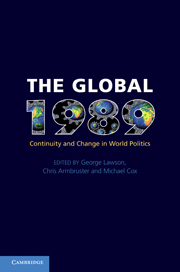Book contents
- Frontmatter
- Contents
- List of figures
- List of tables
- Notes on contributors
- Acknowledgements
- List of abbreviations
- Introduction: the ‘what’, ‘when’ and ‘where’ of the global 1989
- Part I What and when
- 1 Back to the future of nineteenth-century Western international thought?
- 2 The return of primitive accumulation
- 3 What is left after 1989?
- Part II Where
- Part III Continuity and change
- Conclusion: was there a global 1989?
- Bibliography
- Index
2 - The return of primitive accumulation
Published online by Cambridge University Press: 05 June 2012
- Frontmatter
- Contents
- List of figures
- List of tables
- Notes on contributors
- Acknowledgements
- List of abbreviations
- Introduction: the ‘what’, ‘when’ and ‘where’ of the global 1989
- Part I What and when
- 1 Back to the future of nineteenth-century Western international thought?
- 2 The return of primitive accumulation
- 3 What is left after 1989?
- Part II Where
- Part III Continuity and change
- Conclusion: was there a global 1989?
- Bibliography
- Index
Summary
The return of primitive accumulation
1989 marks the rise of histories other than those of democracy and freedom. These are histories made in the wake of the shift to a unipolar world dominated by a sharp rise in US power. Alongside the emergence of the United States as the world's sole global power, 1989 also signals an unsettling and debordering of existing arrangements within the deep structures of capitalist economies. Here we find new modes of profit extraction in the most unlikely places, modes that have now become systemic to the extent of being hard-wired into the functioning of the capitalist system itself. Since 1989, countries in the Global South have become subject to a form of financial control – carried out by institutions like the International Monetary Fund (IMF) – which operates as a worldwide financial disciplinary regime. Survival here hinges on exporting and trafficking people because it is the one resource that many of these countries have. Indeed, the rise in people trafficking has become the last hope for survival not just for ordinary households in poor countries, but for a number of actors ranging from small entrepreneurs to governments.
Countries in the Global North have their own version of this parallel history. Prominent here is the growing informalisation of work, the sharp downgrading of the manufacturing sector, and the explosion of high-risk finance, all of which took off in the post-1989 period.
- Type
- Chapter
- Information
- The Global 1989Continuity and Change in World Politics, pp. 51 - 75Publisher: Cambridge University PressPrint publication year: 2010
- 7
- Cited by

